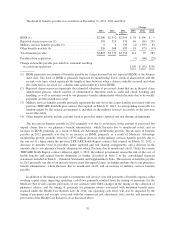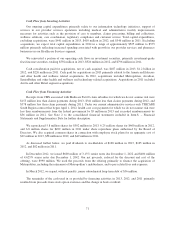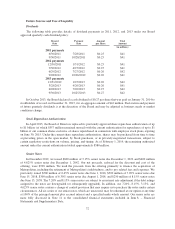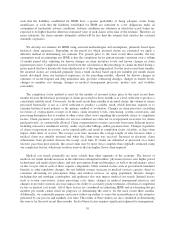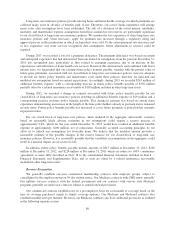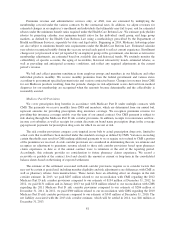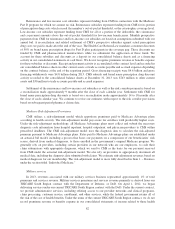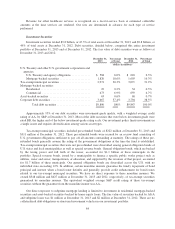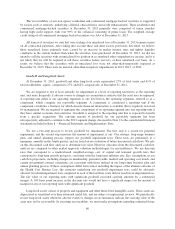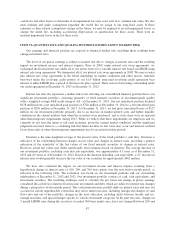Humana 2013 Annual Report Download - page 90
Download and view the complete annual report
Please find page 90 of the 2013 Humana annual report below. You can navigate through the pages in the report by either clicking on the pages listed below, or by using the keyword search tool below to find specific information within the annual report.Long-term care insurance policies provide nursing home and home health coverage for which premiums are
collected many years in advance of benefits paid, if any. Therefore, our actual claims experience will emerge
many years after assumptions have been established. The risk of a deviation of the actual interest, morbidity,
mortality, and maintenance expense assumptions from those assumed in our reserves are particularly significant
to our closed block of long-term care insurance policies. We monitor the loss experience of these long-term care
insurance policies and, when necessary, apply for premium rate increases through a regulatory filing and
approval process in the jurisdictions in which such products were sold. To the extent premium rate increases and/
or loss experience vary from our loss recognition date assumptions, future adjustments to reserves could be
required.
During 2013, we recorded a loss for a premium deficiency. The premium deficiency was based on current
and anticipated experience that had deteriorated from our locked-in assumptions from the previous December 31,
2010 loss recognition date, particularly as they related to emerging experience due to an increase in life
expectancies and utilization of home health care services. Based on this deterioration, and combined with lower
interest rates, we determined that our existing future policy benefits payable, together with the present value of
future gross premiums, associated with our closed-block of long-term care insurance policies were not adequate
to provide for future policy benefits and maintenance costs under these policies; therefore we unlocked and
modified our assumptions based on current expectations. Accordingly, during 2013 we recorded $243 million of
additional benefits expense, with a corresponding increase in future policy benefits payable of $350 million
partially offset by a related reinsurance recoverable of $107 million included in other long-term assets.
During 2012, we recorded a change in estimate associated with future policy benefits payable for our
closed-block of long-term care insurance policies resulting in additional benefits expense of $29 million and a
corresponding increase in future policy benefits payable. This change in estimate was based on current claim
experience demonstrating an increase in the length of the time policyholders already in payment status remained
in such status. Future policy benefits payable was increased to cover future payments to policyholders currently
in payment status.
For our closed block of long-term care policies, when modeled in the aggregate, unfavorable scenarios
based on reasonably likely adverse variations in our assumptions could require a reserve increase of
approximately 9.6%, which for the year ended December 31, 2013 would have resulted in additional benefits
expense of approximately $100 million, net of reinsurance. Generally accepted accounting principles do not
allow us to unlock our assumptions for favorable items. We believe that the modeled amount provides a
reasonable estimate of the possible changes in the reserve balance for our closed-block of long-term care
insurance policies. However, it is reasonably possible that the variability in assumptions, in the aggregate, could
result in a material impact on our reserve levels.
In addition, future policy benefits payable include amounts of $215 million at December 31, 2013, $220
million at December 31, 2012, and $224 million at December 31, 2011 which are subject to 100% coinsurance
agreements as more fully described in Note 18 to the consolidated financial statements included in Item 8. –
Financial Statements and Supplementary Data, and as such are offset by a related reinsurance recoverable
included in other long-term assets.
Revenue Recognition
We generally establish one-year commercial membership contracts with employer groups, subject to
cancellation by the employer group on 30-day written notice. Our Medicare contracts with CMS renew annually.
Our military services contracts with the federal government and our contracts with various state Medicaid
programs generally are multi-year contracts subject to annual renewal provisions.
Our commercial contracts establish rates on a per employee basis for each month of coverage based on the
type of coverage purchased (single to family coverage options). Our Medicare and Medicaid contracts also
establish monthly rates per member. However, our Medicare contracts also have additional provisions as outlined
in the following separate section.
80


